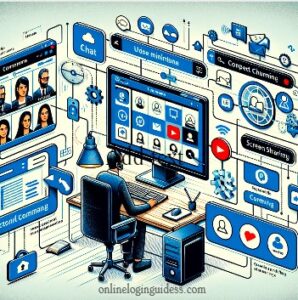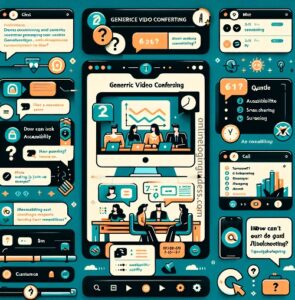Lync Conf Revolutionizing Communication in the Tech World (Update)
Introduction In an era where seamless communication forms the backbone of tech innovation, Lync Conf has emerged as a

Introduction
In an era where seamless communication forms the backbone of tech innovation, Lync Conf has emerged as a pivotal tool for tech professionals and businesses alike. This software, now operating under the name Microsoft Teams, revolutionized how teams across the globe collaborate and communicate. Today, we will explore the significance of Lync Conf, a platform that has transformed virtual meetings and collaborative workspaces, making it indispensable for modern tech enterprises.
Impact on Business Communication
Lync Conf’s impact on business communication has been profound. By providing a platform that can handle diverse communication needs, it has enabled businesses to streamline their operations and improve productivity. Teams can collaborate more effectively, develop ideas more rapidly, and respond to challenges with agility. With features like presence indicators, team members can easily see who is available to connect, fostering a more spontaneous and dynamic work environment. As businesses continue to adapt to the demands of a digital world, the legacy of Lync Conf, now Microsoft Teams, continues to shape the future of workplace communication.

Evolution of Lync Conf
Lync Conf, initially launched by Microsoft as a part of its unified communications suite, has undergone significant evolution since its inception. Originally designed to simplify communication within business environments, it offered instant messaging, audio, and video conferencing capabilities. Over the years, it evolved to integrate advanced features like real-time collaboration and document sharing.
The transition to Skype for Business marked another milestone in its evolution, introducing more sophisticated functionalities tailored to enterprise-level communication needs. This evolution paved the way for what we now know as Microsoft Teams, a powerful all-in-one platform that combines the best of Lync Conf’s legacy with cutting-edge innovations. The continuous evolution of Lync Conf reflects the growing demand for integrated communication solutions in an increasingly digital world.

Key Features and Benefits
Lync Conf’s array of features set it apart as a leading communication tool in the tech industry. One of its standout features is the ability to host high-quality video conferences with minimal latency, even in low-bandwidth environments. This ensures that tech teams can connect seamlessly, regardless of their geographical locations.
Another key benefit is its integration with other Microsoft Office applications. This allows users to collaborate on documents, spreadsheets, and presentations in real-time, boosting productivity and streamlining workflows. Additionally, Lync Conf offers robust security measures, ensuring that sensitive information shared during conferences remains protected.
The platform’s user-friendly interface makes it accessible to individuals of varying tech proficiency levels. This inclusivity fosters collaboration between tech teams, bridging the gap between departments and enhancing overall organizational efficiency.
Case Studies
Numerous organizations have leveraged Lync Conf to tackle unique tech challenges, yielding impressive results. One notable example is a multinational software company that faced difficulties in coordinating its teams spread across different continents. By adopting Lync Conf, they were able to conduct regular virtual meetings, facilitating real-time collaboration and accelerating project timelines.
In another instance, a tech startup utilized Lync Conf to enhance remote work efficiency during the COVID-19 pandemic. The platform enabled them to maintain seamless communication among team members, ensuring uninterrupted project development and client interactions.
These case studies highlight Lync Conf’s adaptability and effectiveness in addressing diverse communication needs within the tech sector, making it a valuable asset for organizations seeking to optimize their operations.
Future of Lync Conf
The future of Lync Conf promises exciting possibilities in the tech landscape. With the rapid advancement of artificial intelligence and machine learning, we can expect Lync Conf to incorporate more intelligent features that enhance meeting experiences. AI-driven transcription services, automated meeting summaries, and sentiment analysis are just a few examples of how Lync Conf could evolve.
Furthermore, the integration of virtual and augmented reality technologies holds the potential to redefine remote collaboration. Imagine attending virtual meetings in immersive 3D environments, where participants can interact with digital objects and experience a heightened sense of presence.
The future of Lync Conf is closely intertwined with the broader trends in digital transformation, ensuring that tech professionals will continue to rely on this platform as a catalyst for innovation and collaboration.
Challenges and Considerations
While Lync Conf, now Microsoft Teams, has proven to be a robust tool in the tech world, there are challenges and considerations that organizations must address to maximize its potential. One major concern is the need for continuous training and adaptation as new features and updates are rolled out. As tech teams rely heavily on this platform for communication, ensuring that all users are well-versed in its capabilities is crucial for maintaining workflow efficiency.
Another consideration is the dependence on stable internet connectivity. Despite Lync Conf’s low-bandwidth functionality, poor internet quality can still affect the quality of video conferences and real-time collaboration efforts. Businesses need to invest in reliable internet solutions to mitigate these issues.
Moreover, with the increasing amount of sensitive data being exchanged over virtual platforms, security remains a top priority. Organizations must implement stringent data protection policies and continuously monitor for potential vulnerabilities within their communication systems.
By addressing these challenges, companies can fully leverage the transformative power of Lync Conf, turning potential pitfalls into opportunities for growth and efficiency in a dynamic tech-driven environment.

How to Use Lync Conf
To maximize the benefits of Lync Conf, tech professionals can employ several best practices. First and foremost, it’s crucial to ensure that all team members are familiar with the platform’s features and functionalities. Conducting training sessions can help bridge knowledge gaps and empower users to utilize Lync Conf effectively.
Consistency in scheduling virtual meetings and maintaining a structured agenda can significantly enhance productivity. Leveraging features such as screen sharing and collaborative document editing during meetings can lead to more dynamic and engaging interactions.
Additionally, integrating Lync Conf with project management tools can streamline workflows and ensure that communication aligns seamlessly with ongoing projects. By following these practical tips, tech professionals can harness the full potential of Lync Conf to drive their initiatives forward.
Tips for Optimizing Remote Collaboration
Remote collaboration has become an integral part of modern work environments, and optimizing this process can lead to enhanced productivity and innovation. One key tip is to establish clear communication channels and protocols for team members. This ensures that everyone understands where and how to communicate pertinent information, reducing the risk of miscommunication.
Time management is another critical aspect of successful remote collaboration. Implementing tools that facilitate task scheduling and deadline tracking can help team members stay on top of their responsibilities. Regular check-ins and updates keep everyone aligned and aware of project progress.
Embracing flexibility while setting boundaries is also essential. Encouraging team members to balance flexibility in their work schedules with a commitment to agreed-upon meeting times promotes a healthy work culture while maintaining accountability.
Finally, fostering a sense of community and team spirit, even in a virtual setting, can significantly boost morale and collaboration. Engaging in team-building activities, recognizing individual and group achievements, and promoting an inclusive environment can make remote teamwork rewarding and effective. By incorporating these practices, organizations can optimize remote collaboration, driving their success in an increasingly digital world.

Conclusion
In conclusion, Lync Conf has emerged as a trailblazer in revolutionizing communication within the tech community. Its evolution from a simple communication tool to a comprehensive collaboration platform underscores its significance in today’s fast-paced digital world. By offering key features, real-world success stories, and a glimpse into its promising future, Lync Conf continues to empower tech professionals and organizations to achieve their goals with efficiency and precision.
FAQs

What is Lync Conf, and how does it differ from traditional communication tools?
Lync Conf, now known as Microsoft Teams, is a unified communications platform that integrates features like video conferencing, instant messaging, and document collaboration. Unlike traditional tools, it offers seamless integration with Microsoft Office applications and advanced security features.
Can small businesses benefit from using Lync Conf?
Absolutely! Lync Conf’s user-friendly interface and affordability make it accessible to businesses of all sizes. Small businesses can leverage its features to enhance communication, improve remote work efficiency, and compete effectively in the digital marketplace.
Is Lync Conf secure for sharing sensitive information during meetings?
Yes, Lync Conf prioritizes security with robust encryption and authentication measures, ensuring that sensitive information shared during meetings remains confidential and protected.
By leveraging Lync Conf effectively, businesses can unlock new levels of productivity and collaboration, ultimately driving success in the tech industry.











